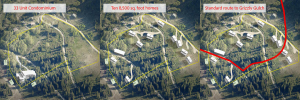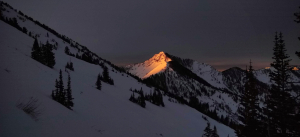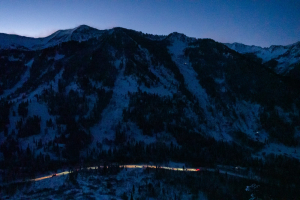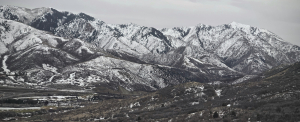Doug Tolman
Aspens over Asphalt: No New BCC Parking Lot
Solitude Mountain Resort, under the ownership of Alterra Mountain Company, has submitted a proposal to build a new, paved, 593-space parking lot in Big Cottonwood Canyon (BCC) — directly across SR 190 from Solitude Village.
To do so, they would clear-cut a thriving stand of Quaking Aspen, excavate a steep slope with retaining walls as high as 40 feet, and pave over land perched above Mill F Fork of Big Cottonwood Creek. This project threatens not only the canyon’s scenic character and ecological resilience, but also raises major safety concerns for canyon travelers.
The access road would cross protected watershed lands owned by Salt Lake City Public Utilities (SLCPU), relying on a tenuous claim of a historic jeep trail as legal justification. Meanwhile, the project would create a de facto four-way intersection at a dangerous and already congested section of SR 190, compounding the infamous “red snake” traffic and jeopardizing public safety.
This proposal isn’t about solving parking; it’s about increasing Solitude’s skier capacity. More parking means more traffic, longer lift lines, and more stress on an already overloaded canyon. We acknowledge the need for a transportation solution, but the answer isn’t more parking, more cars, and more development.
Impacts to the Land
This parcel of land is home to a healthy stand of Quaking Aspen, an outstanding natural firebreak, biodiverse habitat, and icon of Big Cottonwood Canyon’s cultural identity. Due to human disturbance and changes in climate, Quaking Aspen populations and overall health have been in decline for decades, leading to increasingly large fires and less diverse habitat. A majority of the canyon is considered “Very High” wildfire risk by the State of Utah’s wildfire risk index, removing this fire resilient species while also introducing more human activity into the area could increase that risk (think - more hot cars and cigarette butts). Below the parking lot is Mill F fork of Big Cottonwood Creek, meaning any development will impact downstream water quality. Though some engineering measures can be taken to reduce impacts to the watershed, any paved surface will inevitably increase erosion, and the extra surface area requiring snow removal will add more salt to the watershed.
Parking, Safety and Congestion
We share common ground with Solitude in the agreement that fewer cars should be parked on the side of the highway, however we drastically differ in proposed solutions (Click here to read our comments on the ongoing BCC Environmental Study). Rather than investing in improved transit solutions to bring visitors to the resort base or implementing skier capacity limits to ease congestion, Solitude has chosen instead to clear-cut a thriving stand of healthy Quaking Aspen to make way for a 593-space parking lot. This short-sighted decision not only sacrifices critical forest habitat, but also undermines opportunities for sustainable, dispersed recreation transportation solutions in the Wasatch. According to the February 2025 Town of Brighton Newsletter, there are 240 roadside parking spaces in inventory along SR 190 between Willow Fork and Brighton resort, meaning that even if all of those spaces were removed, this parking lot would result in a net gain of over 350 spaces. This equation, which also includes Brighton Resort patrons who are unlikely to park so far down the canyon, shows that hundreds of additional parking spaces are not about transportation solutions, but increasing resort capacity. If the goal is to limit congestion and improve safety in the canyon, adding more cars will never be the answer. Furthermore, changes required to make this intersection and pedestrian crossing safe will bring traffic to a stand-still – an ikonic mistake.
The U.S. Forest Service (USFS) regulates visitor capacity in Big Cottonwood Canyon based on available parking. While Solitude claims this simply replaces existing roadside parking, there is no binding guarantee those roadside spaces will be permanently removed.
 Location of the proposed pedestrian crossing
Location of the proposed pedestrian crossing
Questionable Property Access
The proposed parking lot does not border any existing roadways, though there is a small historic jeep track connecting it to Old Stage Road. Old Stage Road itself is a quaint, narrow passage to a few summer homes, and a well-loved track for backcountry recreationists accessing USA Bowl and Willow Fork. The unimproved jeep track which no longer sees motorized use is more akin to a hiking trail. This track connects Solitude’s parcel to Old Stage Road over approximately 150 feet of land owned and preserved by Salt Lake City Public Utilities (SLCPU) to protect water resources. Solitude’s application hinges on the claim that this short, unimproved, rarely used track qualifies for a prescriptive easement. They further claim that it entitles them to build a paved, 2-lane, engineered road switchbacking across over 1,000 feet of this land they do not own on a completely different part of the property.
The Conditional Use Permit Application
Solitude’s initial Conditional Use Permit application for a 720-space parking lot was submitted in February 2025, and determined to be deficient by the Greater Salt Lake Municipal Services District. In April 2025, the resort submitted supplemental materials to address the deficiencies, the updated plan included a survey of the property and slightly smaller lot size.
The Town of Brighton’s code identifies the Planning Commission as the land use authority for conditional use permits. Leading up to and during the hearing, property owners and residents of Brighton will be the primary voice to ensure that this bad project is killed. We anticipate this application to be heard by the Planning Commission in the very near future – there will be a 10-day notice to town residents before the hearing. By state law, the Planning Commission must approve a Conditional Use Permit application if the detrimental effects of the proposal can be “reasonably mitigated” – a term that has an inherent amount of subjectivity. That means this hearing is not about what the community considers favorable, but about the detrimental effects of this proposal, and lack of ability to reasonably mitigate them. The truth is that adding 593 parking spots to the canyon will negatively impact traffic congestion, adjacent parcels, pedestrian safety, fire risk, habitat integrity, water quality, and public land access in ways that cannot be reasonably mitigated.
After the Planning Commission makes their determination, the decision may be appealed to the Land Use Hearing Officer – a likely outcome regardless of the Planning Commission’s determination.
Town of Brighton General Plan
Shortly after the Town of Brighton incorporated, leadership produced the Town of Brighton General Plan with significant community input. This document, published in 2022 and required by state code, acts as a long term planning guide for the town, including the parcel that Solitude intends to build on. The General Plan states that the Planning Commission should use the General Plan "when considering any land use decision as big as the redevelopment of multiple properties or as small as minor design guidelines for a commercial sign. When confronted with a decision that requires the balancing of the rights of a property owner with the overall public interest, this General Plan can assist in weighing the issues and prioritizing what is important.” There are a number of goals in this master plan related to land use, transportation, and natural resources, yet none of them call for additional parking, pavement or cars in the canyon. In fact, many of them point towards minimizing impacts on the environment while maintaining the character of Brighton. Some related goals include:
- LLU1-O1 Restore healthy and resilient trees and forests through land-use regulations.
- LU2-O4 Reduce traffic congestion and increase safety by creating appropriate and sustainable parking standards unique to Brighton’s mix of uses
- T1-O1 Find solutions to provide year-round [transit] service in the canyon.
- T2-O4 Build infrastructure that reduces impacts on wildlife.
- NR1-O4 Preserve open lands that are crucial for wildlife and reduce the potential for open lands to be developed for housing or urban growth.
When characterizing the future of the residential area this parcel is in, the Brighton Town Master Plan states: “This area will see little change in land use over time but may shift focus toward creating safe, environmentally conscious properties that can make the community more resilient”. A 593-space parking lot that removes an entire stand of Quaking Aspen is in direct opposition to this characterization, the overall town vision and specific goals of the Town of Brighton.
Our Ongoing Questions
- The proposed access road and pedestrian crossing are between 2 blind turns, where the current speed limit is 45mph. How would adding this proposed parking lot impact safety and congestion for people accessing the upper canyon? What measures would be taken to mitigate those effects?
- Before determining that more parking was needed, did Solitude attempt to coordinate with UDOT, UTA, and the Town of Brighton to improve transit systems, reducing the number of personal vehicles in the canyon?
- Does a 150-foot historic jeep trail entitle Solitude to build a graded, paved, 2-lane road that would switchback over 1,000 feet of property they don’t own? Could the impacts to neighboring property owners be reasonably mitigated?
- How can the impacts to habitat connectivity, water quality, and wildfire risk caused by paving over a Quaking Aspen stand be reasonably mitigated?
- If this parking lot were built, would the roadside parking used by people accessing public land be removed? Would this lot serve only Solitude customers, or would it be accessible to anyone visiting the canyons for dispersed recreation? And if so, would Solitude charge the public to park on land altered for its private gain?
Our Take
We agree that Highway 190 should not be used as a parking lot—but that’s where our agreement with Solitude ends.
Instead of investing in sustainable year-round transit or placing reasonable caps on daily skier volume, Solitude is proposing to bulldoze a healthy, resilient stand of Quaking Aspen, degrade a critical watershed, fragment wildlife habitat, and pave a new road across land they do not own—all to build a 593-space parking lot. This is not a traffic solution; it’s an expansion plan.
If we’re serious about solving canyon congestion, we must remove cars from the road—not create more reasons for people to drive. Paving over forests to build more parking only invites more traffic, more emissions, and more danger, while locking us deeper into a car-dependent system that clearly isn't working.
This proposal also flies in the face of the Town of Brighton’s General Plan, which calls for restoring forest health, limiting new development, and prioritizing transit-first strategies. The negative impacts—to water quality, fire safety, traffic risk, and the wild character of the canyon—are extensive and irreversible.
We stand with the Brighton community in opposing this reckless and short-sighted project, and we’ll continue to keep you informed on how to get involved and stop this Ikonic mistake.
Additional Resources
Help preserve Albion Basin and access to Grizzly Gulch!
The Town of Alta is currently accepting public comments on a significant development proposal that will affect the future of Albion Basin and access to Grizzly Gulch. The deadline to submit comments is Friday, March 28 at 11:59 PM. Though only open for 3 days, this optional feedback form is one of many steps that will take place in the planning process over the coming years. Save Our Canyons has requested a 30-day extension of the feedback form, we will keep you updated if it is extended, and about future opportunities to shape the outcome of this proposed development.
Click here to submit your feedback before Midnight on 3/28!
More details:
In 2014, the Estate of JoAnne L. Shrontz was permitted to develop ten 8,500 square foot homes along the Albion Basin Summer Road, right in the middle of the standard backcountry touring approach to Grizzly Gulch. 11 years later, the developer submitted a new development concept that replaces those homes with a six-story condominium building at the lower portion of the parcel and the creation of a perpetual conservation easement on the upper 20 acres above the Albion Basin Summer Road. This plan is being presented as an alternative to a previously permitted 10-lot residential subdivision, which includes no conservation protections. Because this development on privately-owned land was already permitted in 2014, the ability to completely stop this development is limited. This alternative does, however, present an opportunity to consolidate impacts to a smaller footprint and solidify access to backcountry recreation.
The Summer Road is a beloved gateway to some of the most treasured backcountry destinations in the Wasatch: Grizzly Gulch, Wolverine Cirque, and Patsey Marley. Any development in this area will have lasting consequences for ecosystem health, water quality, recreational access, and traffic congestion in an already overburdened Canyon.
While Save Our Canyons would prefer neither option come to fruition, we believe that consolidating development near the base of the property is the lesser of two evils. The proposed conservation easement would help ensure the upper portion remains undeveloped and limit future attempts to widen the Summer Road—an important protection for the character and ecological integrity of the area.
We strongly urge the Alta Planning Commission to:
- Propose a third alternative that shortens the height of the proposed 6-story condominium to reduce impacts on the character and beauty of Albion Basin.
- Guarantee public access to Grizzly Gulch, Patsey Marley, and Wolverine Cirque in perpetuity by including it within the conservation easement.
- Increase the percentage of workforce housing units in the condominium development to reduce Canyon congestion and support workers who struggle to find stable housing options in Little Cottonwood Canyon.
Our Submitted Responses
If you had to choose one of these two development concepts, which would you choose?
Condominium Building with Conservation Easement above the Summer Road
Why do you prefer that alternative to the other? What do you think the pros and cons to each alternative are?
The single-family unit alternative presents several concerns for Save Our Canyons and our members. It would contribute to the sprawl of development into relatively undisturbed alpine lands, impacting overall ecosystem function and increasing the likelihood of conflicts between private homeowners and recreators. This alternative does not include a conservation easement, leaving the area more vulnerable to future development pressures. Additionally, any increase in housing capacity, especially those that are not designated for worker housing, will inevitably lead to increased Canyon congestion. However, this option does offer the advantage of a shorter building height, which may result in less visual impact on the surrounding landscape.
The condominium alternative also poses challenges. Its taller building height will negatively affect the pristine visual character of the upper Canyon. While an extra 3 units of workforce housing will be helpful, 30 new units of non-worker housing will certainly increase congestion in an already overloaded Canyon. On the other hand, it includes a conservation easement that would place meaningful limits on future development and help preserve public access for recreation—an important consideration in long-term land use planning. For this alternative to be successful and well-received by the community, we suggest shortening the overall height and increasing the percentage of workforce housing units, without expanding the footprint.
Please provide any additional comments, thoughts or feelings on the development alternatives. Please keep in mind that more steps remain in the process before any development concept moves forward.
While Save Our Canyons would prefer neither option come to fruition, we prefer consolidated development near the base of this property. We believe the conservation easement will ensure the upper area is not developed in the future, and would limit any further attempts to widen the summer road.
We encourage the Town of Alta Planning Commission to ensure public access to Grizzly Gulch, Patsey Marley, and Wolverine cirque are protected in perpetuity, and request it be designated in the conservation easement. While we do not want to see a 130,000 sq. ft condo, we encourage the Commission to push for an increase in the percentage of workforce housing units in the condo development. This will limit impacts of the development on Canyon congestion, while supporting the workers who already have a difficult time finding stable housing in the Canyon. Further, to reduce disturbance of the Canyon’s visual character, we request a new alternative that shortens the height of the proposed condominium without expanding the footprint.
Any development in pristine alpine lands will disturb ecosystem function, water quality, traffic congestion, and habitat connectivity. Our hope is that the Town of Alta planning commission will choose the lesser-of-evils, and preserve public access while doing so.
Take Action
Click here to submit your comment before Friday, March 28 at 11:59 PM
Your voice matters. Encourage the Town of Alta to prioritize conservation, access, and long-term sustainability in its planning process. Let’s protect the beauty and wildness of the Wasatch Mountains for future generations.
2025 Legislative Session Recap
The 2025 Utah General Legislative Session just concluded after 45 days chock-full of bills that would have negatively impacted the beauty and wildness of the Wasatch. Luckily we have you - dedicated members of Save Our Canyons who show up time and time again in the name of preservation.
Help Block Two Bad Bills - NO SB 337 or SB 316!
Updated 3/6/25
Good news, your advocacy is working!
In the second half of the 2025 Utah Legislative Session, we asked Save Our Canyons members to contact elected officials about two bills that would have been bad news for the Wasatch. Together, we sent nearly 3,000 messages to Senators and Representatives voicing our concerns, and it worked! Thanks to your advocacy, Senate Bill 337 was never brought to a floor vote, and Senate Bill 316 was substituted to remove the most concerning section.
SB 337 - Land Use and Development Amendments
Senate Bill 337 would have established the “Beehive Development Authority”. Among other duties, this quasi-governmental entity would have funneled taxpayer dollars into major development projects with little community involvement or oversight.
The Community Impact Projects established by the authority would have been initiated and led by developers, offering limited opportunities for genuine community input—despite the inclusion of the word “community” in the name. Our primary concern is that this would have created a pot of taxpayer money that ski resorts and gravel pit operators could have used for private development here in the Wasatch. Along with many other groups concerned about this power grab, we were successful in stalling the momentum of this bill to prevent it from passing this legislative session.
Though the bill has no feasible way of moving forward, we will continue tracking it along with other bills to ensure there is no funny business. Read more on SB 337’s demise in this Salt Lake Tribune article.
SB 316 - Military Installation Development Authority and Other Development Zone Amendments
Senate Bill 316 is the annual clean-up bill for the Military Installation Development Authority (MIDA). In addition to funding defense developments in the state, MIDA is responsible for funding ski resort expansion in the Wasatch to the tune of several hundred-million dollars.
To learn more, read these Salt Lake Tribune articles about MIDA-funded developments at both Sundance and Deer Valley. We are very concerned about the misuse of MIDA bonds to facilitate resort expansion in the Wasatch, but our primary concern with this bill was a provision allowing MIDA to act as the lead agency in the National Environmental Policy Act (NEPA) process.
This would have allowed this quasi-governmental authority to assume the role of a state agency in Environmental Impact Statements and Assessments in sensitive ecosystems. After over 2,000 messages to elected officials, the sponsor of this bill removed that provision in the third substitute, which was adopted. Save Our Canyons is still very critical of the misuse of MIDA funds for ski resort developments, and will continue to oppose any expansion of this authority until our concerns are addressed.
What's next?
We are never shocked to see bad bills surface in the final week of the Utah Legislative Session—it’s a tactic we’ve come to expect. Rushed, last-minute proposals like these are designed to limit public scrutiny and fast-track developments that would otherwise face serious opposition. Though we dodged a few bullets this session, there is still plenty of work to be done to limit the amount of taxpayer dollars subsidizing private development in the Wasatch. We will continue to watch these efforts vigorously, and keep you updated with any ways you can help preserve the beauty and wildness of the Wasatch.
Yours for the Wasatch,
Save Our Canyons Team
Where the Rubber Hits the Snow
UPDATE February 10, 2025:
After a narrow loss on the House Floor on 2/5, this bill was reintroduced by Representative Christine Watkins on 2/6. We are excited to announce that it passed the House on the second attempt, and has moved along to the Senate where it will hopefully be assigned to committee in this week. We urge you to reach out to your Senator to voice support for this bill as it moves through the Senate. Click here to find your Senator and their contact info.
Early during this 2025 Utah General Legislative Session, HB 196 - Vehicle Traction Amendments was introduced by Representative Gay Lynn Bennion. This bill exemplifies a low-impact, cost-efficient solution to improve congestion issues both across the state and in the Tri-Canyon area. While solving the transportation problem isn’t the core of our mission, we believe that solutions like this can add up to address the bigger problems that impact the overall health of the Wasatch Mountains and that changes to existing programs can effectively reduce the congestion issues plaguing our Canyons. Representative Bennion represents House District 41, which includes the Cottonwood Canyons and Cottonwood Heights, areas frequently impacted by congestion caused by drivers without traction devices such as snow chains or snow tires. We support and commend this statewide effort that will have significant local impacts. The first section of this bill simply clarifies language around Traction Law, but the rubber hits the snow where it gives rulemaking authority to the Utah Department of Transportation (UDOT) for traction control issues, and local highway authorities (Like UDP) the ability to implement ordinances concerning when and how the law is implemented, including before a predicted storm. Furthermore, this bill codifies that a person who violates this policy or any associated ordinances may be ticketed up to $750. This proposed policy change is compatible with our vision for a healthier, safer, and congestion-free Wasatch, which also includes a connected transportation plan, along with improved bus services in the valley and Canyons for more equitable access.More on Traction Law
Utah administrative rule R920-6 authorizes UDOT and local law enforcement to require traction devices on all vehicles traveling certain sections of highways during severe winter weather events. When traction law is enforced in the Cottonwood Canyons, travelers are notified by signs at the base of the Canyons, on the UDOT Cottonwood Canyons website and on their Instagram page. In addition to a minimum tire tread depth of 5/32”, the following equipment is required in the Canyons when Traction Law is in effect:
2WD vehicles must have 3-peak mountain snowflake (3PMSF) tires on all four wheels or snow chains/snow socks on at least two wheels.
4WD vehicles must have M+S or M/S all-season tires on all four wheels, though adding snow chains, snow socks, or 3PMSF tires improves safety and reliability.
To streamline the inspection process, drivers who meet these requirements are eligible to participate in the UDOT Cottonwood Canyons Sticker Program, which includes free pre-inspection at a number of participating tire shops. Voluntary participation in this program is intended to streamline the inspection process at in-canyon enforcement points to limit congestion.
Initially implemented in 2018, Traction Law has been difficult for officials to enforce due to lack of resources and authority. This has allowed many drivers to skirt the rules; in frequent and unfortunate cases, these drivers become the head of the infamous Red Snake by causing accidents, slide-offs, and spin-outs. A portion of the Cottonwood Canyons Transportation Investment Fund was allocated for public safety enforcement in 2024 (HB 488), a first step to address the lack of resources, leading to increased enforcement this season. 2025’s HB 196 is the next step in ensuring there is proper authority and accountability to enforce Traction Law and an example of how consistent efforts can solve problems on the ground.
Building on these efforts, we would like to see future changes that support improved transit infrastructure in the valley to connect people to the Canyons via buses, along with enhanced service in the Canyons. Complementary measures that include tolling for automobiles, parking reservation systems, and a visitor capacity study will help ensure that we do not love the Wasatch to death.
We applaud this effort by Representative Bennion as part of a larger effort to promote public safety and reduce congestion in the Wasatch. We see on-the-ground efforts like this as critical to addressing the transportation issues facing our community, curtailing any arguments for off-the-ground development projects.
H.B. 355 Mining and Critical Infrastructure Materials Amendments
Updated 3/5/25
As initially written, HB 355 would have dramatically increased the likelihood of the proposed gravel pit in Parley's Canyon. After two substitutions, the definition of a "vested critical infrastructure material use" has been altered to the point where that is unlikely - watch the House Floor Debate to hear the sponsor's statements on the matter. Along with other groups opposed to the proposed gravel pit in Parley's Canyon, Save Our Canyons members sent over 10,000 messages to elected officials asking them to oppose or substitute this bill. This public input was incredibly successful, contributing to the bill's substitution and allowing us to disable our action alert.
Though there are still concerning loopholes opened up by this bill that could impact Parley's Canyon, the official position of Salt Lake County is that direct impacts to the proposed gravel pit are now unlikely. This bill does however raise major concerns around the rights of cities and counties to determine where and how they source aggregates for developments. We understand that as Utah grows, more aggregate will be needed. We support informed decision-making by local authorities to determine the best places to source aggregate with community input. As it stands, we disagree with the overall intention of the bill because it overrides local authority, but we appreciate the sponsor's efforts to work with Salt Lake County to find common ground.
Primary Concerns:
- This bill would permit gravel pit operators to expand operations to every square inch of land they own or purchase before 1/1/2026, as long as they get proper permits from the Utah Department of Environmental Quality.
- In many instances this could override local land-use authority, such as Salt Lake County's 2022 ban on mines in the Foothills and Canyons.
- This bill would shift the burden of proof from the mine operator to the public. If a gravel pit use is either not "vested" or would be harmful to a local community, it would be up to that community to expend resources proving that.
- Unfettered expansion of existing gravel pits caused by this bill would undoubtedly impact local water resources, air quality, property values, recreation economy, and neighboring wilderness areas.
We believe that the communities that see both the benefits and impacts of expanded gravel mines should have the authority to determine where those gravel mines are placed.











